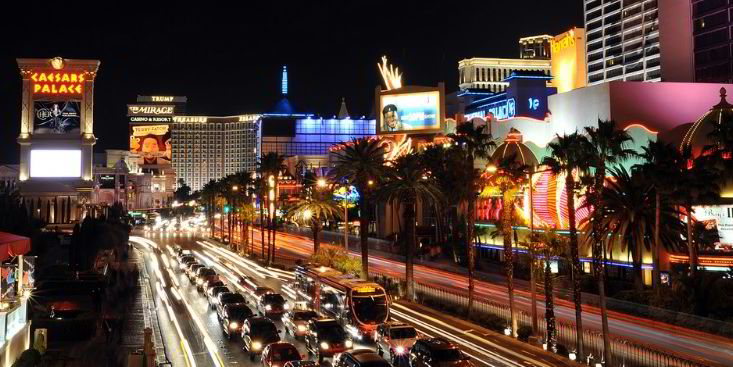Given that puzzling reality, Las Vegas – a city steeped in contradiction – seemed an apt choice for this year's Solar Power International, the largest solar trade show in the world's second-largest market.
US solar is a picture of dynamism, putting the rest of the world to shame with its consistent, near clockwork-like growth. So far this century, the US solar market has never suffered a down year. In 2015 the US added a record 7.3GW of new solar capacity, and this year the total will be around 12GW.
Each year PV technology, both hardware and software, gets cooler. Panels get cheaper, sleeker, and more powerful. Potential customers can now use cloud-based software to determine how much they would save with PV modules, given their unique homes and patterns of electricity consumption. SunPower has started using drones to evaluate large-scale project sites.
This is not your father's – or even your older brother's – solar industry.
It's not controversial to predict that solar will soon consistently be the largest source of new power generation capacity in the US, and it may stay there for decades.
And unlike nearly every other energy source, where the only real action is at the big end of things, American solar is booming both at the utility-scale and on rooftops, weaving itself into the physical fabric of society in a way no generation technology ever has.
Yet despite all these advantages, a glance at the health of the main US solar companies – and others around the world, for that matter – could easily lead a person to assume this is in fact an industry in crisis.
SunEdison, the Icarus of the modern renewables sector, is currently being carved up in bankruptcy court.
First Solar and SunPower, two industry bellwethers and unquestioned innovators, are both trading near multi-year lows, and loss-making SunPower recently announced plans to lay off 1,200 workers, or 15% of its global workforce.
The picture is no prettier downstream. Developers of large-scale projects are struggling to turn a buck in a world of cheap gas, brutal PPA prices, and insufficient climate policies. And the three largest US rooftop players – SolarCity, Sunrun and Vivint Solar – are adrift in red ink and face a highly uncertain future.
Amid this swirl of confusing signals, the US solar industry descended on the Vegas strip to thrash out the most pressing issues of the day, with the ring-ting-ting of slot machines never far from earshot.
Utility chiefs saluted the incoming tidal wave of distributed PV while fretting about its impact. Panel makers worried aloud about how low prices will fall in this latest industry down cycle.
Distributed PV executives assailed the ceaseless assault on net-metering, and private-equity bosses mused about the sector looking rather ripe for the picking at today's stock prices.
The spirited debates befitted the venue: the storied Westgate Hotel & Casino (née the International), which has hosted Muhammad Ali fights, held concerts by Elvis and Liberace, and served as the fictitious "Whyte House" hotel in the 1971 James Bond film Diamonds Are Forever.
None of the discussions at SPI were quite up to the task of untangling the industry's chief riddle: the lack of sustainable profitability for many solar companies despite the roaring market.
Yet the truly amazing trick of the solar industry is that such a question can almost feel like a sideshow. What stands out more than anything at an event like SPI is the air of invincibility the solar industry exudes, in spite of everything.
No one, not even solar's natural enemies, would dare question the paramount role solar will play in the global energy mix in the decades ahead. And ironically, the solar industry of today suffers from that universal optimism.
The solar manufacturing sector, for example, could desperately do with a heavy round of consolidation. But who wants to exit an industry that is widely believed to be at the beginning of decades – perhaps centuries – of growth? Better to hang on, somehow.
Everyone wants to be in solar – an industry of deep imagination and ambition – and everyone is playing the long game. Encouragingly, that extends to the nation's solar workers, the thousands of people of all ages and races who wandered the floors at SPI – shaking hands, sharing ideas, and stealthily slipping job offers under the table.
There are workers from just about every industry in solar today, but it seems especially from other energy fields -- from oil to wind. And none of them seem to have any intention of switching fields again.
The names at the top of their business cards may change, and, for that matter, so might the companies at the top of the industry. But the workers themselves are staying put in solar.
In all likelihood, the big picture for US solar will be pretty similar a year from now, although the next person sitting in the White House – the real White House – will have an impact on the mood and perhaps the market.
A year from now, solar energy will be cheaper and more competitive than ever, and yet profits will still be elusive for many solar and storage companies.
Perhaps it makes sense, then, that SPI will be returning in 2017 to the cacophony of Vegas, a city in which chaos is the only certainty.
In Dispatches, Recharge journalists offer a personal insight into the issues shaping the development of renewable energy around the world.

